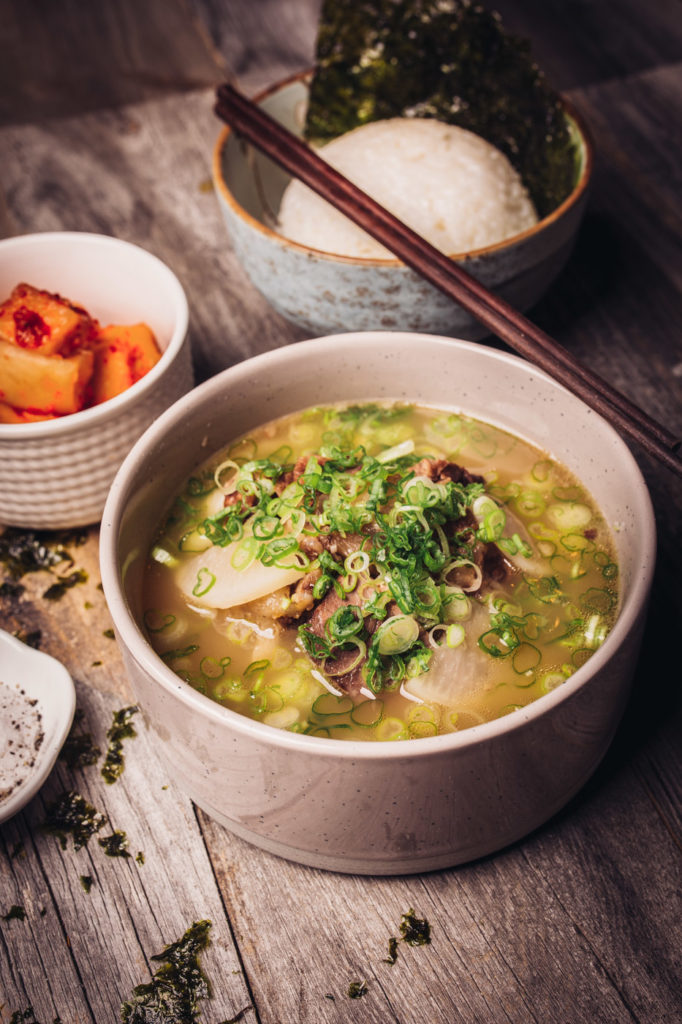
Kkori Gomtang
Yield: 14 servings
Time: 12 hours
Soups are extremely prevalent in Korean culture, and can find their way into almost any meal of the day. This particular dish is made with boiled beef, and is rumored to have been a preference of the noble class during the Joseon Dynasty, which spanned five centuries.
This was the soup I requested from my mother on the weekly, and I have fond childhood memories of her making this for me. If you don’t have access to oxtails, just supplement with another cut of meat.
When you set aside the cooked meat at step 12, I would recommend covering the cooked meat with some of the stock. This will prevent the meat from drying out while you’re waiting for your stock to finish.
Around the world and throughout history, soup has been a humble way for cultures to survive. Even a quick look at cuisines globally reveal soup’s ubiquity; and although they’ve often been functional, failsafe form of sustenance, that hardly means they’re boring. In a simple bowl of soup, we see culture come alive, brimming with local ingredients. It’s a full creative expression of the people who invented each and every one.
Ingredients
For the broth:
- 3 lb. ox femur bones
- 3 lb. ox feet
- 2 lb. beef brisket, cut into 3-inch chunks
- 2 lb. oxtail
- 1 large Korean radish, cut into 4-inch chunks
- 1 white onion, halved, skin on
For the garnish:
- Thinly-sliced green onions
- Kosher salt
- Ground black pepper
- Soy sauce
- Rice vinegar
Method
For the broth:
- Put all bones and meat into a large mixing bowl and cover with cold water. Let sit for 1 ½ hours to remove all blood and impurities, changing the water as needed.
- Drain the water and rinse the bones and meat in cold water to remove any excess fat and bone chips.
- Add the bones and meat to a large 32-40 quart stock pot, then cover with enough cold water to cover the meat by 1 inch.
- Bring to boil on high, for about 30 minutes.
- Turn off the heat and strain the bones and brisket out of the pot, discarding the water.
- With cold water, rinse and scrub the bones and meat of any excess fat, impurities and bone chips.
- Clean the stock pot thoroughly to remove all fat, then add the clean bones and brisket to the pot.
- Add the white onion and Korean radish to the pot.
- Cover with water until the water hits 4 inches below the top of the pot.
- Put the heat on high and bring to a boil.
- When boiling, lower heat; cover and hard simmer for 3 hours.
- After 3 hours, remove the radish, brisket and oxtails and set aside to cool. Once cool, cover with enough liquid from the stock to cover completely and refrigerate.
- Continue hard simmering the bones for about 6 hours. Check the stock periodically to make sure it is not boiling, and that there is enough water in the pot. If the water level gets too low, add more water. You will want to end up with about 50% reduction in water at the end.
- At 6 hours, check the stock to see if it’s to your desired consistency. It should be gelatinous and sticky on your mouth and cloudy white in color. If it’s not there yet, simmer longer and check in 30 minute increments. Make sure your water level doesn’t get too low!
- Once you’ve reached the desired consistency, cool the broth completely, cover, then put into the fridge overnight or until fat has congealed (6 or more hours).
- Once the fat has congealed, use a slotted spoon or a small sifter to remove and discard the fat.
For serving:
- Add the amount of oxtail you want to serve into a pot of broth.
- Heat the broth on high until boiling.
- Slice the reserved brisket and radish into thin slices and place them into individual bowls.
- While the broth heats, prepare garnishes:
- Thinly-sliced green onions
- Kosher salt
- Ground black pepper
- 70/30 blend of soy sauce and rice vinegar for dipping oxtail meat
- When the broth starts to boil, ladle the broth and oxtail into the prepared bowls and let your guests garnish and season as desired.
- Serve with a side of rice and kimchi.






Our comments section is for members only.
Join today to gain exclusive access.